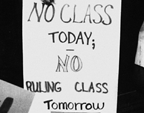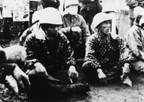Bullet Films
“The existing world order is collapsing and over the last few years we have been able to glimpse through the cracks signs of something new to come in the world of film, occurring parallel to this collapse. This movement, rather than making films that simply conclude as documents, sticks fast to reality and vigorously opposes everything fake in the world. France’s Etats Generaux du Cinéma, born out of the May revolution, stopped the Cannes Film Festival with its force, and unremittingly continued to document the events of that May. Meanwhile in the U.S., Newsreel, a group set up to ‘expose the reality whitewashed by the gigantic media industry—a reality predicting a future for our group—is showing up the great falsehoods of that great country. In its filming this movement thrusts itself into the midst of conflict and changes anger at authority and calls for freedom into anger at oneself. It is a powerful weapon for reality. It is called Bullet Films.”
—Ogawa Productions, film rental list (pub. July 1970)
This passage conveys the excitement and resolution of purpose garnered from having the strong support of a global network. Both Ogawa Productions and Newsreel cultivated this sense of solidarity, swapping and distributing films with organizations in France, Germany, Cuba, and elsewhere. We could possibly explain this phenomenon in terms of links forged between individuals, but perhaps other approaches can give us a broader view. Several of the works in this program (Black Panther and Columbia Revolt) are already included in the “Birth of Newsreel, 1968” but here we see Ogawa Productions’ stirring dubbed versions, revealing high expectations of their audiences’ reactions and resulting in works with a feel different from the originals. This program includes other works from 1968 produced along similar lines.
Haight-Ashbury
- 7 min / B&W / 1968
San Francisco’s left-wing movement experienced an upsurge in 1968. Haight-Ashbury depicts young people building a community of fraternity and their clashes with police, with the song “San Francisco” playing in the background. Although a Newsreel piece, the print shown in this program is the sole copy in existence in Japan. It has seldom been screened since being made and was not included on the Ogawa Productions film rental list.
 Columbia Revolt
Columbia Revolt
- Japanese dubbed version / 50 min / B&W / 1968
“In April 1968, Columbia University students went on strike, protesting against the university’s racism and military research conducted in collusion with the Department of Defense. But far from accepting the students’ demands, the university authorities deemed the protest unlawful and refused to recognize it. The students fought back with an occupation. This documentary of the students’ fight was shot from within the occupied campus.”
—Ogawa Productions, film rental list (pub. July 1970)
Hanoi, Tuesday the 13th
- 35 min / Color, B&W / 1968 / Source: Kyodo eiga
The Vietnamese people endured countless invasions in the past, but never gave in. Production and the anti-aircraft battle continue amidst U.S. bombing. This film shows us the full-force U.S. bombardment of Hanoi on Tuesday the 13th, prisoners of war driven back by returned fire, and young men walking past them heading for the front line. Directed by Santiago Alvarez.
 Black Panther—Off the Pig
Black Panther—Off the Pig
- Japanese dubbed version / 15 min / B&W / 1968

“‘The revolution’s here. No more pigs in our community.’ When black people are arrested they sing this song in protest. And they think: ‘The Black Panthers feel the same way as the twelve people who started the Cuban Revolution. We are simply the vanguard of the revolution and we plan to teach the people the strategy and the necessary tools to liberate themselves.’ And then they return to their song.”
—Ogawa Productions, film rental list (pub. July 1970)
 What Am I, a Robot?
What Am I, a Robot?
- Japanese dubbed version / 25 min / B&W / 1968

“A device that automatically sounds an alarm if you take your hand off the handle for more than two seconds or grip the handle for more than fifty-five seconds was called the ‘dead man’ by French engineers. This device rendered 20,000 engineers jobless. In the midst of the May general strike, the engineers begin to fight back, returning pressure from management and the pre-existing left with some of their own.”
—Ogawa Productions, film rental list (pub. July 1970)
 Paris in the Month of May
Paris in the Month of May
- Japanese dubbed version / 35 min / B&W / 1968
“You can hear the cries for freedom. The burning barricades. The calls of ‘revolution—oui’ and the roar of the sirens. Tear-gas canisters are fired in succession as if by machine gun and countless flares explode in the night sky. ‘Comrades! Comrades! Rue Saint-Michel has already been shut off. All turned to asphalt. There are no more cobblestones. Comrades! Go deep into the Latin Quarter. Pick up a stone! Walk down a street with stones!’ Twenty-five thousand workers, university and high school students occupied the Latin Quarter for seven days. The force which had built over fifty barricades on the street turned into a pillar of flames when it burned on May 10, 1968.”
—Ogawa Productions, film rental list (pub. July 1970)
What Am I, a Robot? and Paris in the Month of May were obtained by Ogawa Productions through ties with groups like Etats Generaux, the French association of independent directors, but the precise background of these two works is unclear. What Am I, a Robot? concludes with police patrolling a university campus, and the name Langlois graffitied on a building can be discerned. Langois was head of the Cinémathèque Française, and his sudden forced resignation incited the French film world to revolt. This rapidly escalated and is said to have developed into Paris’ May Revolution. That year the Cannes Film Festival was cancelled.
YIDFF Opening Screening
Three Day War in Narita (New print)
(“Sanrizuka, dai sanji kyosei sokuryo soshi toso”) 50 min / B&W / 1970 / Source: Yamagata Documentary Film Library
50 min / B&W / 1970 / Source: Yamagata Documentary Film Library
Despite fierce protests to block construction of the Narita airport, the Airport Corporation again forced the start of surveying for the second-stage of construction. As a helicopter hovers in the sky and riot police break through the black smoke, farmers repeatedly unleash desperate attacks using feces bombs and sit-ins. The surveying, which had been planned to run for a week, ends on the third day. Three Day War in Narita is the third work in Ogawa Productions’ Sanrizuka series, and was influenced by Newsreel and made on an emergency basis in a very short time. Directed by Ogawa Shinsuke; photography by Tamra Masaki.
A Report from Haneda
(“Gennin hokokusho”)- 58 min / B&W / 1967 / Source: Yamagata Documentary Film Library
1967 witnessed a rising tide against the American war of invasion in Vietnam. Protests on October 8 to prevent Prime Minister Sato from visiting Vietnam and again on November 12 to block his trip to the U.S. marked the peak of this mass movement. In the October 8 struggle Yamazaki Hiroaki, a student at Kyoto University, was killed. The film probes the cause of death and exposes the violence of the authorities. Like The Oppressed Students, it was screened at universities around the country and received widespread support from students, especially New Left Wing student activists. But it was strongly criticized by film critics. Produced by a film committee formed principally from the Iwanami Productions Labor Union, Group Vision, and the Independent Screening Organization, which had branches throughout the country (most members were students.) Directed by Ogawa Shinsuke.
Forest of Youth
(“Ao no mori”)- No sound / 40 min / B&W / 1968-69 / Source: Planet Bibliothèque de Cinéma
In the late 1960s Osaka was home to the Osaka Independent Film Center and the Kinki chapter of the Independent Screening Organization. The former produced Summer in Osaka, 1968 and Whiplashed People (“Muchiutarerumono”), and the latter was the Kansai base for Ogawa works including Sea of Youth, The Oppressed Students and A Report from Haneda, and screened Dead, Come and Cut off My Retreat and Oe Masanori’s Newsreel films. Members advocated “raw” anti-war film—what might be called Japan’s version of Newsreel—and ordered college film clubs to capture their own protests on celluloid. This piece is one of the results, documenting protests at Kwansei Gakuin University. Concerned less with finishing touches, this piece goes for an in-your-face depiction of the situation at hand. Said to be shown to all students interested in joining Kwansei Gakuin University’s film studies club.
 ’68 Okinawa—Japan
’68 Okinawa—Japan
(“Okinawa—Nippon 1968”)- 8 min / B&W / 1968 / Source: Isaka Yoshiyuki
Depicts the movement for the reversion of Okinawa to mainland Japan, interconnected with protests in Japan including the campaign against the U.S. Army hospital at Camp Oji, protests to keep nuclear submarines from Sasebo harbor, and the Sanrizuka anti-Narita Airport movement. The film searches for commonalities, and shows the barriers obstructing the movements in Okinawa and Japan proper.
Deliberately using no narration, ’68 Okinawa is compiled from footage shot on location, using raw audio and comments by people at the sites of action. Cinematography enhances the compellingly realistic photos, creating images that seem to leap from the screen. Sticking to the principles of Cinetract, there are no subtitles, credits for crew members or music, and the absence of end credits signifies that the situation continues. The film follows the premise of valuing the audiences’ interpretations of the images, asking viewers to respond according to their own sensibilities. It was produced by cameramen (and women) from Iwanami Productions Labor Union and their freelance counterparts, who got passports and traveled independently to Okinawa from 1967 to 1968.
• Yamagata Newsreel! | Birth of Newsreel, 1968 | Women’s Newsreel | Bullet Films | Internet Activism | Newsreel Related Screenings |
